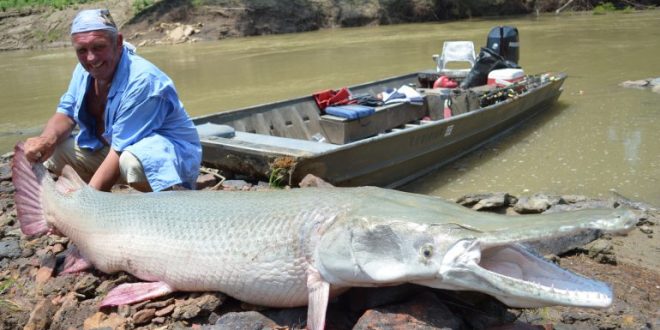Researchers are reintroducing Alligator gar into a number of locations in a bid to help them win the war against invasive Asian carp.
The alligator gar is being seen as a valuable fish in its own right.
Specifically, it’s being seen as a potential weapon against a more threatening intruder: the invasive Asian carp. “What else is going to be able to eat those monster carp?” says an alligator gar expert at Nicholls State University in Louisiana. “We haven’t found any other way to control them.” Gar have shown a taste for the carp, and they’re now being restocked in lakes, rivers, and backwaters—sometimes in secret locations—in states from Illinois to Tennessee. Still, the extent to which gar can control carp isn’t well understood, and some people are skeptical. “I don’t think alligator gar are going to be the silver bullet that is going to control carp by any stretch of the imagination,” an Illinois biologist says.
Of the seven known gar species, the alligator is the largest, reaching up to ten feet (three meters) long and tipping the scales at up to 300 pounds (140 kilograms). These menacing-looking behemoths are generally olive green or yellow and have a heavily scaled body. A tooth-filled mouth and wide, alligator-like snout give the species its name.
These freshwater giants may look fierce, but attacks against people are unknown. They can pose a passive danger, though—the fish’s eggs are poisonous to humans if ingested.
Adult gars have few natural predators, although alligators have been known to attack them. Young are preyed upon by larger fish. Alligator gars prey on fish, but they are opportunistic and have been known to feed on everything from waterfowl and small turtles to carrion.
Alligator gars are found throughout much of the coastal U.S. Southeast. They inhabit waters as far west as Texas and Oklahoma, as far north as the Mississippi River Basin and the lower Ohio and Missouri river systems, and southern drainages well into Mexico.
Gars inhabit lakes, bayous, and bays and are able to tolerate brackish and even salt water. But these toothy giants prefer large, slow-moving rivers, particularly those with wide floodplains, where shallow waters provide hatchlings with some protection from predators.
Unfortunately for the alligator gar, flood-control measures such as dams and dikes have dramatically altered their riverine ecosystems and largely eliminated their preferred spawning habitats across North America. These breeding challenges have contributed to significant population declines across much of the animal’s range.
Alligator gars are also targeted by both commercial and sport fisheries and have frequently been overfished. They are now protected by law in parts of their range.
Agencies/Canadajournal
 Canada Journal – News of the World Articles and videos to bring you the biggest Canadian news stories from across the country every day
Canada Journal – News of the World Articles and videos to bring you the biggest Canadian news stories from across the country every day



